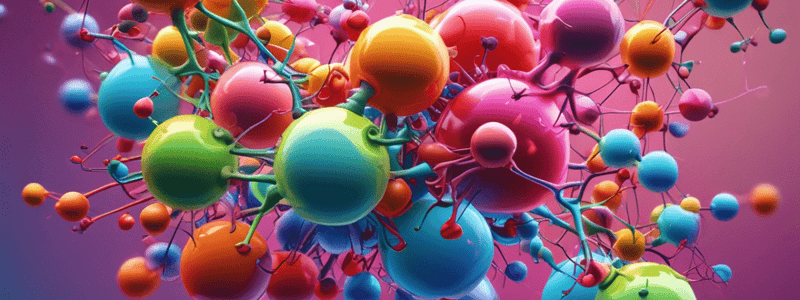Podcast
Questions and Answers
Where are the substances mentioned in the text initially released from?
Where are the substances mentioned in the text initially released from?
- Blood vessels
- Digestive system
- Respiratory system
- Body tissues (correct)
Which of the following processes do the substances undergo within the body tissues?
Which of the following processes do the substances undergo within the body tissues?
- Absorption
- Chemical transformations (metabolism) (correct)
- Excretion
- Transportation
What is one of the purposes of the metabolic processes mentioned in the text?
What is one of the purposes of the metabolic processes mentioned in the text?
- Storing nutrients
- Synthesizing new molecules
- Regulating body temperature
- Releasing energy (correct)
In which tissues do the metabolic processes mentioned in the text occur?
In which tissues do the metabolic processes mentioned in the text occur?
Which of the following is NOT mentioned in the text as a part of the metabolic processes?
Which of the following is NOT mentioned in the text as a part of the metabolic processes?
Which type of compounds, in addition to ATP, have high energies of hydrolysis?
Which type of compounds, in addition to ATP, have high energies of hydrolysis?
What is the significance of phosphorylated compounds with high energies of hydrolysis?
What is the significance of phosphorylated compounds with high energies of hydrolysis?
What does a large negative G0 value for hydrolysis indicate?
What does a large negative G0 value for hydrolysis indicate?
Why are phosphorylated compounds important in biological processes?
Why are phosphorylated compounds important in biological processes?
What is a common characteristic of compounds with high phosphoryl-group transfer potential?
What is a common characteristic of compounds with high phosphoryl-group transfer potential?
What is the primary role of redox reactions in metabolism?
What is the primary role of redox reactions in metabolism?
Which of the following is an example of an H-carrier molecule?
Which of the following is an example of an H-carrier molecule?
What is the primary function of H-carrier molecules in metabolism?
What is the primary function of H-carrier molecules in metabolism?
Which of the following is a consequence of redox reactions in metabolism?
Which of the following is a consequence of redox reactions in metabolism?
How do H-carrier molecules participate in redox reactions?
How do H-carrier molecules participate in redox reactions?
What is the primary function of NAD+ in cells?
What is the primary function of NAD+ in cells?
If all the NAD in a cell is in the reduced form (NADH), what would be the consequence?
If all the NAD in a cell is in the reduced form (NADH), what would be the consequence?
Which of the following statements about NAD+ is incorrect?
Which of the following statements about NAD+ is incorrect?
What is the relationship between NAD+ and NADH?
What is the relationship between NAD+ and NADH?
In which cellular process is the NAD+/NADH ratio particularly important?
In which cellular process is the NAD+/NADH ratio particularly important?
What is the primary use of the free energy released during cellular respiration?
What is the primary use of the free energy released during cellular respiration?
Which of the following molecules are oxidized during cellular respiration and can be reused in catabolism?
Which of the following molecules are oxidized during cellular respiration and can be reused in catabolism?
What is the primary function of ATP in a cell?
What is the primary function of ATP in a cell?
Which of the following statements about cellular respiration is true?
Which of the following statements about cellular respiration is true?
What is the role of NAD+ and FAD in cellular respiration?
What is the role of NAD+ and FAD in cellular respiration?
Flashcards are hidden until you start studying




